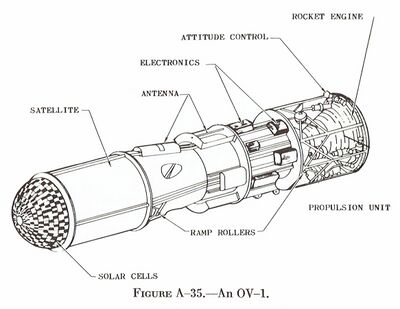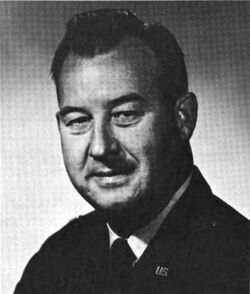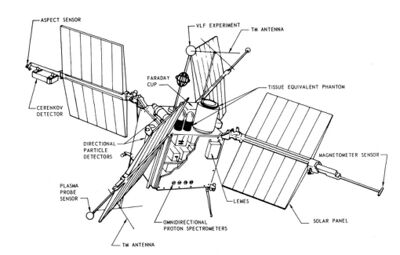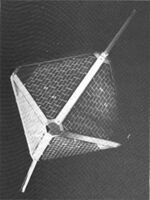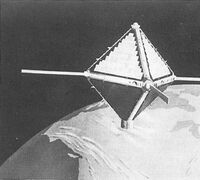Engineering:Orbiting Vehicle
Orbiting Vehicle or OV, originally designated SATAR (SATellite - Atmospheric Research), comprised five disparate series of standardized American satellites operated by the US Air Force , launched between 1965 and 1971. Forty seven satellites were built, of which forty three were launched and thirty seven reached orbit. With the exception of the OV3 series and OV4-3, they were launched as secondary payloads, using excess space on other missions. This resulted in extremely low launch costs and short proposal-to-orbit times. Typically, OV satellites carried scientific and/or technological experiments, 184 being successfully orbited through the lifespan of the program.
The first OV series, designated OV1, was built by General Dynamics and carried on suborbital Atlas missile tests; the satellites subsequently placed themselves into orbit by means of an Altair-2 kick motor. The Northrop-built OV2 satellites were built using parts left over following the cancellation of the Advanced Research Environmental Test Satellite; three OV2 spacecraft flew on Titan IIIC test flights. Space General built the OV3 satellites, the only series to be launched on dedicated rockets; six were launched on Scout-B rockets between 1966 and 1967. OV4 satellites were launched as part of a test flight for the Manned Orbiting Laboratory (MOL), with two satellites conducting a communications experiment whilst a third, OV4-3, was the primary payload, a boilerplate mockup of the MOL space station. Two further OV4 satellites, duplicates of the first two, were built but not launched. OV5 satellites were launched as secondary payloads on Titan IIIC rockets as part of the Environmental Research Satellite program.
The OV program was phased out in the late 1960s, the last of the series (an OV1) flying in 1971. It was succeeded by the Space Test Program, which focused on tailored satellites with specific payloads rather than standardized ones.
Program origin
The Orbiting Vehicle satellite program arose from a US Air Force initiative, begun in the early 1960s, to reduce the expense of space research. Through this initiative, satellites would be standardized to improve reliability and cost-efficiency, and where possible, they would fly on test vehicles or be piggybacked with other satellites. In 1961, the Air Force Office of Aerospace Research (OAR) created the Aerospace Research Support Program (ARSP) to request satellite research proposals and choose mission experiments. The USAF Space and Missiles Organization created their own analog of the ARSP called the Space Experiments Support Program (SESP), which sponsored a greater proportion of technological experiments than the ARSP.[1]:417 Five distinct OV series of standardized satellites were developed under the auspices of these agencies.[1]:425
Summary of launches
| Series | Contractor | First launch | Last launch | Built | Launched | Failed to orbit |
|---|---|---|---|---|---|---|
| OV1 | General Dynamics | 1965-01-21 | 1971-08-07 | 23 | 23 | 4 |
| OV2 | Northrop | 1965-10-15 | 1968-09-26 | 5 | 3 | 0 |
| OV3 | Space General AFRCL |
1967-04-22 | 1967-12-04 | 6 | 6 | 1 |
| OV4 | US Air Force Martin Marietta |
1966-11-03 | 1966-11-03 | 5 | 3 | 0 |
| OV5 | TRW Systems AFRCL Northrop |
1967-04-28 | 1969-05-23 | 9 | 8 | 1 |
OV1
Background
The OV1 series was an evolution of the 2.7 m "Scientific Passenger Pods" (SPP), which, starting on 2 October 1961, rode piggyback on suborbital Atlas missile tests and conducted scientific experiments during their short time in space. General Dynamics received a $2 million contract on 13 September 1963 to build a new version of the SPP (called the Atlas Retained Structure (ARS)) that would carry a self-orbiting satellite. Once the Atlas missile and ARS reached apogee, the satellite inside would be deployed and thrust itself into orbit. In addition to the orbital SPP, General Dynamics would create six of these satellites, each to be 3.66 m (12.0 ft) long with a diameter of .762 m (2 ft 6.0 in), able to carry a 136 kg (300 lb) payload into a circular 805 km (500 mi) orbit.
Dubbed "Satellite for Aerospace Research" (SATAR), the series of satellites was originally to be launched from the Eastern Test Range on Atlas missions testing experimental Advanced Ballistic Re-Entry System (ABRES) nosecones. However, in 1964, the Air Force transferred ABRES launches to the Western Test Range causing a year's delay for the program. Moreover, because WTR launches would be into polar orbit as opposed to the low-inclination orbits typical of ETR launches, less mass could be lofted into orbit using the same thrust, and the mass of the SATAR satellites had to be reduced.[1]:417
Spacecraft
The standard OV1 satellite, 1.387 m (4 ft 6.6 in) long and .69 m (2 ft 3 in) in diameter, consisted of a cylindrical experiment housing capped with flattened cones on both ends[2] containing 5000 solar cells producing 22 watts of power. Two .46 m (1 ft 6 in) antennae for transmitting telemetry and receiving commands extended from the sides of the spacecraft. 12 helium-pressurized hydrogen peroxide thrusters provided attitude control. Starting with OV1-7, the solar cells were flat rather than rounded, and the satellites carried the Vertistat attitude system that used a Sun sensor to determine the spacecraft's orientation to the Sun.[1]:418–429 OV1-13 and OV1-14 were the first in the OV1 series to use Pulse-code modulation digital telemetry, which afforded the return of more and more precise data from the satellites.[3]
Operations
Ultimately, only the first of the SATARs, (OV1-1, called Atmospheric Research Vehicle (ARV) at the time)[4]:24 ever flew piggyback on an ABRES mission. The rest were flown on ex-ICBM Atlas D and F boosters specifically purchased by the OAR for the OV1 series (except OV1-6, which flew on the Manned Orbiting Laboratory test flight on 2 November 1966).[1]:418–422 Typically, the satellites were mounted in the nose cone of the launching rocket; OV1-1, OV1-3 and OV1-86 were side mounted. A jettisonable propulsion module with an Altair 2 solid-propellant motor provided the thrust for final orbital insertion.
The OV1/Atlas combination was economical for the time, costing just $1.25 million per launch ($4545 per 1 kg (2.2 lb) of payload). The standardized format also afforded a quick experiment proposal-to-launch period of just fifteen months.[1]:418 The program was managed by Lt. Col. Clyde Northcott, Jr.[5]
Significant results
Data from OV1-4's Tissue Equivalent Ionization Chamber, compared to a similar instrument orbited on Gemini 4, determined the radiation dose Gemini astronauts traveling at OV1-4's altitude (~950 km (590 mi)) would receive: 4 rads per day at a 30° inclination orbit or 1.5 rads per day at a 90° (polar) inclination orbit.[6]
In late May 1967, during a period of high solar and magnetic activity, OV1-9 returned the first evidence of Earth's long theorized but never measured electric field. The satellite detected a stream of protons flowing out of the atmosphere into space moving at more than 60,000 km (37,000 mi) per second. OV1-9 also studied the variation of proton fluxes in the outer Van Allen Belt during that same period, determining that fluxes were ten times greater four days after May's maximum solar activity than they had been before the flare; it took ten days for the fluxes to return to normal levels.[7] The X-ray spectrometer on the co-launched OV1-10 returned the most comprehensive set of solar X-ray observations to date. These data enabled scientists to determine the relative density of neon to magnesium in the solar corona through direct observation rather than using complicated mathematical models. The ratio of neon to magnesium was found to be 1.47 to 1 (+/- .38).[8]
OV1-13, launched 6 April 1968, measured increases in energy and intensity of electrons during a geomagnetic storm that took place 10 June 1968.[9] OV1-13 data also clarified how the particle flow caused by solar storms created these high altitude increases.[10]
Data returned by OV1s 15 and 16 returned the first substantial set of data on the density of Earth's atmosphere between the altitudes of 100 km (62 mi) and 200 km (120 mi) and proved that increased solar activity increased the air density at high altitudes, contradicting the prevailing model of the time. [11] Moreover, the satellites determined that the density of the upper atmosphere was 10% lower than predicted by theoretical models.[12] OV1-15/16 data led to improved atmospheric models that allowed the Air Force to better predict where and when satellites would decay and reenter.[11]
OV1 Missions
| Name | Mass | COSPAR ID | Launch | Reentry | Remarks |
|---|---|---|---|---|---|
| OV1-1 | 21 Jan 1965[13] | Geophysics; first westward launch of a satellite; orbited, but on-board Altair failed to fire.[4]:24 | |||
| OV1-2 | 86 kg (190 lb) with Altair booster[14] | 1965 078A | 5 Oct 1965[13] | Radiation studies[15] | |
| OV1-3 | 92 kg (203 lb)[14] | 27 May 1965[13] | Biomedical radiation studies; Atlas failed two minutes into flight.[1]:419 | ||
| OV1-4 | 87.6 kg (193 lb) | 1966 025A | 30 Mar 1966 | Thermal control experiments | |
| OV1-5 | 114.3 kg (252 lb) | 1966 025B | 30 Mar 1966 | Optical radiation test | |
| OV1-6 | 202 kg | 1966 099C | 3 Nov 1966 | 31 Dec 1966 | Inflatable decoy |
| OV1-7 | 117 kg | 14 Jul 1966 | 14 Jul 1966 | Sky science; failed to orbit | |
| OV1-8 | 3.2 kg | 1966 063A | 14 Jul 1966 | 4 Jan 1978 | Passive comsat open aluminum sphere |
| OV1-9 | 104 kg | 1966 111A | 11 Dec 1966 | Radiation studies; discovered Earth's electric field | |
| OV1-10 | 130 kg | 1966 111B | 11 Dec 1966 | 30 Nov 2002 | Radiation studies; studied solar X-rays and Earth's airglow |
| OV1-11 | 134 kg | 27 July 1967 | 27 July 1967 | Failed to orbit | |
| OV1-12 | 140 kg | 1966 072D | 27 July 1967 | 22 Jul 1980 | Radiation studies; also known as Flare Activated Radio-biological Observatory (Faro) |
| OV1-86 | 105 kg | 1966 072A | 27 July 1967 | 22 Feb 1972 | Cosmic ray telescope; Earth's heat radiation |
| OV1-13 | 107 kg | 1968 026A | 6 Apr 1968 | High altitude radiation studies | |
| OV1-14 | 101 kg | 1968 026B | 6 Apr 1968 | EM interference, radiation studies, and Lyman Alpha solar astronomy | |
| OV1-15 | 213 kg | 1968 059A | 11 July 1968 | 6 Nov 1968 | Air density, solar studies; also known as Solar Perturbation of Atmospheric Density Experiments Satellite (Spades) |
| OV1-16 | 272 kg | 1968 059B | 11 July 1968 | 19 Aug 1968 | Ionospheric drag experiment; also known as Cannonball-1 |
| OV1-17 | 142 kg | 1969 025A | 18 Mar 1969 | 5 Mar 1970 | Solar studies |
| OV1-17A | 221 kg | 1969 025D | 18 Mar 1969 | 24 Mar 1969 | Ionospheric studies; also known as Orbis Cal-2 |
| OV1-18 | 1969 025B | 18 Mar 1969 | 27 Aug 1972 | Ionospheric studies | |
| OV1-19 | 1969 025C | 18 Mar 1969 | Radiation studies | ||
| OV1-20 | 1971 061A | 7 Aug 1971 | 28 Aug 1971 | Radar calibration, radiation studies | |
| OV1-21 | 1971 061B | 7 Aug 1971 | Radar calibration, air density studies |
OV2
Background
The OV2 series of satellites was originally designed as part of the ARENTS (Advanced Research Environmental Test Satellite) program, intended to obtain supporting data for the Vela satellites, which monitored the Earth for violations of the 1963 Partial Test Ban Treaty. Upon the cancellation of ARENTS due to delays in the Centaur rocket stage, the program's hardware (developed by General Dynamics) was repurposed to fly on the Titan III[1]:417:422 (initially the A,[18] ultimately the C) booster test launches.[1] The USAF contracted Northrop to produce these satellites, with William C. Armstrong of Northrop Space Laboratories serving as the program manager.[18]
Spacecraft
The OV2 satellites were all designed on the same plan, roughly cubical structures of aluminum honeycomb, .61 m (2.0 ft) in height, and .58 m (1.9 ft) wide, with four 2.3 m (7.5 ft) paddle-like solar panels mounted at the four upper corners, each with 20,160 solar cells. The power system, which included NiCd batteries for night-time operations, provided 63 W of power. Experiments were generally mounted outside the cube while satellite systems, including tape recorder, command receiver, and PAM/FM/FM telemetry system, were installed inside. Four small solid rocket motors spun, one on each paddle, were designed to spin the OV2 satellites upon reaching orbit, providing gyroscopic stability. Cold-gas jets maintained this stability, receiving information on the satellite's alignment with respect to the Sun via an onboard solar aspect sensor, and with respect to the local magnetic field via two onboard fluxgate magnetometers. A damper kept the satellites from precessing (wobbling around its spin axis). Passive thermal control kept the satellites from overheating.[1]:422
Operations
Three OV2 satellites with different mission objectives were originally planned when the OV2 program began.[18] The OV2 series was ultimately expanded to five satellites, all with different goals. Only OV2-5, a radiation and astronomical satellite, achieved a degree of success.[19]
Significant results
OV2-5 proton energy data collected 2–13 October 1968 in the energy range of 0.060 to 3.3 Mev, showed an eight-fold reduction in particle flux between solar storms and quiet periods. Measuring the angle at which protons encountered the satellite also helped refine theoretical models of how the magnetosphere interacts with the flux of charged particles.[20]
OV2 Missions
| Name | Mass | COSPAR ID | Launch | Reentry | Remarks |
|---|---|---|---|---|---|
| OV2-1 | 170 kg[21] (59 kg experimental payload) | 1965 082A | 15 Oct 1965 | 27 Jul 1972 | Monitoring biological hazards of near Earth charged particles; failed to separate from LCS-2 |
| OV2-2 | Cancelled when the Titan-3C test program was changed; was to have conducted optical measurements from orbit. | ||||
| OV2-3 | 193 kg | 1965 108A | 21 Dec 1965 | Radiation studies; the payload failed to separate from the Transtage and contact was lost after launch. | |
| OV2-4 | Cancelled when the Titan-3C test program was changed; designed to observe radiation from trans-lunar orbit | ||||
| OV2-5 | 204 kg | 1968 081A | 26 Sep 1968 | Radiation studies: cosmic rays, trapped particle fluxes and changes in fluxes arising from solar and geomagnetic disturbances |
OV3
Background
Unlike the OV1 and OV2 series satellites, which were designed to use empty payload space on rocket test launches, the six OV3 satellites all had dedicated Scout boosters. In this regard, the OV3 series was more akin to its civilian science program counterparts (e.g. Explorer). OV3 differed from NASA programs in its heavy use of off-the-shelf equipment, which resulted in lower unit cost.
The first four satellites in the series were made the Aerojet subsidiary Space General Corporation under a $1.35m contract awarded 2 December 1964, the first satellite due October 1965. The last two satellites were built by Air Force Cambridge Research Laboratory (AFCRL), which also managed the entire series and provided four of the OV3 payloads.[1]:422–423
Charles H. Reynolds, who worked at AFCRL from 1955, was the technical manager for the OV3 program.[22]
Spacecraft
The OV3 satellites were octagonal prisms, .74 m (2 ft 5 in) in length and width (for OV3-5 and OV3-6, length was reduced to .53 m (1 ft 9 in)), with experiments mounted on booms. 2560 solar cells provided 30 Watts of power. The satellite was spin-stabilized, but because it was asymmetrical once its booms were extended,[23] OV3-2 maintained its attitude in orbit with a precession damper.[1]:422–423 The spacecraft was spin stabilized at 8 revolutions per minute (rpm)[21] A sun sensor, as well as an onboard tri-axial magnetnometer, gave information on the satellite's aspect (facing), its spin rate, and rate of precession.[24][1]:423 Design life-span was one year.[1]:423
Operations
The OV3 program ultimately comprised 6 missions, five of them successful. The last (OV3-6) flew on 4 December 1967.[13] The OV3 program was terminated following OV3-6 in favor of the cheaper OV1 program.[1]:423
Significant Results
- OV3-1 had a near polar orbit and returned useful data on the energy and distribution of electrons in the auroral regions.[23]
- Data returned by OV3-4 helped prove and refine theoretical models of radiation dosage an astronaut would receive at orbital altitudes.[6]
- OV3-3 VLF receiver data determined the location of the plasmapause (the outer boundary of the Earth's inner magnetosphere).[25]
- OV3-2 observed ambient charged particle variations before, during, and after the 12 November 1966 South American solar eclipse.[26] OV3-2 also conducted ionospheric and aurora research in orbit in conjunction with AFCRL KC-135 aircraft flying underneath, conducting simultaneous measurements.[27] The National Research Council of Canada also conducted coordinated, simultaneous ionospheric observations.[28]
- OV3-6 measured much larger latitude variations than current atmospheric models had expected. A bulge in the neutral density in the summer hemisphere was also discovered. The data obtained was used to construct more accurate atmospheric models, and to correlate physical chemistry reactions to disturbances originating from the sun.[29]
OV3 Missions
| Name | Mass | COSPAR ID | Launch | Reentry | Remarks |
|---|---|---|---|---|---|
| OV3-1 | 68 kg | 1966 034A | 22 Apr 1966 | Radiation studies; OPS-1527 | |
| OV3-2 | 81 kg | 1966 097A | 28 Oct 1966 | 29 Sep 1971 | Radiation studies |
| OV3-3 | 75 kg | 1966 070A | 4 Aug 1966 | Radiation studies (carried instruments originally on the failed OV2-1)[1]:423 | |
| OV3-4 | 79 kg | 1966 052A | 10 Jun 1966 | Radiation studies; also known as Personnel Hazards Associated with Space Radiation (Phasr) or Ops-1427 | |
| OV3-5 | 94 kg | 31 Jan 1967 | Ionospheric studies; also known as Atmospheric Composition Satellite (Atcos)-1; failed to orbit | ||
| OV3-6 | 202 kg | 1967 120A | 4 Dec 1967 | 9 Mar 1969 | Ionospheric studies; also known as Atcos-2 |
OV4
Background
The OV4 series was designed to utilize space aboard the Manned Orbiting Laboratory (MOL) test flights. In September 1964, Raytheon was awarded a $220,000 contract to build a one-off pair of satellites, designed by the U.S.A.F. Avionics Laboratory. These two satellites would investigate long range radio propagation in the charged atmosphere of the ionosphere analogous to the whispering gallery transmission of sounds under a physical dome.[1]:423 In this way, the OV4-1 pair would evaluate the ionosphere's F layer as method of facilitating HF and VHF transmissions between satellites not in line of sight of each other.[16]
Spacecraft
The OV4-1 satellite pair consisted of a transmitting spacecraft and a receiving spacecraft. OV4-1T's transmitter broadcast on three frequencies in the 20-50 MHz range. OV4-1R included receiving equipment and telemetry broadcast equipment. Launched into slightly different 300 km (190 mi) orbits, the satellites would test whispering gallery communications over a range of distances; OV4-1T included a small rocket motor to maximize orbital separation (180°) from OV4-1R.[1]:423
Both satellites were cylindrical, .43 m (1 ft 5 in) in diameter, with domed upper ends. Total length was .9 m (2 ft 11 in). Silver oxide/zinc batteries provided for a 50-day lifespan.[1]:423
Two sets of OV4 "whispering gallery" satellites were built. OV4-2T and OV4-2R were never flown.[1]:423
Operations
OV4-1T and OV4-1R were scheduled for launch on the MOL Heat Shield Qualification flight, with a Titan IIIC rocket. The dummy MOL (a Titan first-stage oxidizer tank) was equipped with a variety of experiments and dubbed OV4-3.[1]:423–424 OV1-6 was also mounted on the Titan III. The rocket took off from Cape Canaveral Launch Complex 40 on 3 November 1966 at 13:50:42 UTC.[13]
OV4 Missions
| Name | Mass | COSPAR ID | Launch | Reentry | Remarks |
|---|---|---|---|---|---|
| OV4-1R | 68 kg | 1966 099B | 3 Nov 1966 | 5 Jan 1967 | "Whispering Gallery" receiver |
| OV4-1T | 109 kg | 1966 099D | 3-Nov-1966 | 11-Jan-1967 | "Whispering Gallery" transmitter |
| OV4-2R | "Whispering Gallery" receiver (cancelled) | ||||
| OV4-2T | "Whispering Gallery" transmitter (cancelled) | ||||
| OV4-3 | 9661 kg | 1966 099A | 3-Nov-1966 | 9-Jan-1967 | Boiler plate model of the Manned Orbiting Laboratory (MOL) to which the reconditioned Gemini 2 (which had been used on a sub-orbital flight on 19 January 1965) was attached; included several experiments; also known as Ops-0855 |
OV5
Background
The OV5 program was a continuation of the Environmental Research Satellite (ERS) series developed by Space Technology Laboratories, a subdivision of TRW Inc. These were very small satellites launched pick-a-back with primary payloads since 1962—a natural fit under the Orbiting Vehicle umbrella. The primary innovation over the earlier ERS series was a command receiver, allowing instructions to be sent from the ground, and a Pulse-code modulation digital telemetry system,[1]:425 versus the analog transmitters used on prior ERS missions.[30] Like prior ERS, the OV5s were spin-stabilized and heat was passively controlled. All of the OV5 series were built by TRW with the exception of OV5-6, built by AFCRL, and OV5-9, built by Northrop Corporation.[1]:425
OV5 Missions
| Name | Mass | COSPAR ID | Launch | Reentry | Remarks |
|---|---|---|---|---|---|
| OV5-1 | 6 kg | 1967 040E | 28 Apr 1967 | Radiation studies; also known as ERS-27 | |
| OV5-2 | 10 kg | 1968 081B | 26 Sep 1968 | 15 Feb 1971 | Materials sciences research; also known as ERS-28 |
| OV5-3 | 8.6 kg | 1967 040D | 28 Apr 1967 | Materials sciences research – materials friction experiment; also known as ERS-20 | |
| OV5-4 | 12 kg | 1968 081C | 26 Sep 1968 | Heat transfer studies; also known as ERS-21 | |
| OV5-5 | 11 kg | 1969 046A | 23-May-1969 | Radiation studies; also known as ERS-29 | |
| OV5-6 | 11 kg | 1969 046B | 23-May-1969 | Solar flare studies; also known as ERS-26 | |
| OV5-7 | Solar studies; cancelled | ||||
| OV5-8 | 9 kg | 16 Aug 1968 | Materials sciences research – materials friction experiment; failed to orbit | ||
| OV5-9 | 13 kg | 1969 046C | 23 May 1969 | Radiation studies – carried low-energy proton detectors, a dE/dx telescope, a Cerenkov counter, a VLF radiation detector, a solar X-ray monitor and a solar flare electron detector to provide further basic research data on solar radiation and its effects on the magnetosphere |
Program conclusion
The OV program was phased out in the late 1960s, the last of the series (an OV1) flying in 1971. The program orbited 184 experiments at extremely low launch costs and with very short proposal-to-orbit times.
OV was succeeded by the Space Test Program, managed by the Space Missile Organization's Space Experiments Support Program, which had absorbed the ARSP in 1968. The Space Test Program followed the new trend in satellites, which preferred custom-built one-offs with specific payloads to vehicles built on standardized plans.[1]:425-426
References
- ↑ 1.00 1.01 1.02 1.03 1.04 1.05 1.06 1.07 1.08 1.09 1.10 1.11 1.12 1.13 1.14 1.15 1.16 1.17 1.18 1.19 1.20 1.21 1.22 1.23 1.24 Powell, Joel W.; Richards, G.R. (1987). "The Orbiting Vehicle Series of Satellites". Journal of the British Interplanetary Society (London: British Interplanetary Society) 40.
- ↑ Krebs, Gunter. "OV1". https://space.skyrocket.de/doc_sdat/ov1.htm.
- ↑ "OV1 Satellites Boosted Into Space by Atlas". 1968 General Dynamics News (Convair): 62. 1968. https://archive.org/details/1968generaldynamicsnews/page/n61/mode/2up?q=%22ov1-13%22.
- ↑ 4.0 4.1 "Aeronautics and Astronautics, 1965". NASA. https://history.nasa.gov/AAchronologies/1965.pdf.
- ↑ "The OV1-Promoter of timely space research". Proceedings of the OAR Research Applications Conference, 14 March 1967. Washington D.C.: Officer of Aerospace Research, United States Air Force. 1967.
- ↑ 6.0 6.1 Cornelius A. Tobias and Paul Todd, ed (1974). Space Radiation Biology and Related Topics Prepared Under the Direction of the American Institute of Biological Sciences for the Office of Information Services, United States Atomic Energy Commission. Academic Press Inc.. p. 68. ISBN 9781483273860. https://books.google.com/books?id=GDLLBAAAQBAJ.
- ↑ Air Force Cambridge Research Laboratories Report on Research for the period July 1967 — June 1970. Bedford, MA: Air Force Systems Command. December 1970. p. 169. https://books.google.com/books?id=4u_fnzEuvVYC&dq=ov1-9&pg=PA169.
- ↑ H.R. Rugge; A.B.C. Walker, Jr (1976). "The Relative Abundance of Neon and Magnesium in the Solar Corona". The Astrophysical Journal 203: L139. doi:10.1086/182038. Bibcode: 1976ApJ...203L.139R. https://ui.adsabs.harvard.edu/link_gateway/1976ApJ...203L.139R/ADS_PDF.
- ↑ Klumpar, David L.; Webber, William R.; Lockwood,John A. (25 January 1974). Analysis of Electron Data from the OV1-13 Satellite. (Report). NEW HAMPSHIRE UNIV DURHAM DEPT OF PHYSICS.
- ↑ Report on Research at AFCRL for the Period July 1970 - June 1972 (Report). The Air Force Cambridge Research Laboratories. February 1973. p. 125. https://books.google.com/books?id=MF2dExiimrsC&dq=%22ov1-13%22&pg=PA125.
- ↑ 11.0 11.1 Kenneth S. W. Champion; F.A. Marcos (23 October 1969). Densities from Satellites OV1-15 and OV1-16 (Report). Air Force Cambridge Research Laboratories. pp. iii,1-2,18. https://books.google.com/books?id=yxJoXtysBUIC&pg=PP8.
- ↑ unknown (1969). "Atmospheric-density accelerometer and low-altitude density satellites (OV1-15 and OV1-16)". OAR progress 1969. p. 123. https://books.google.com/books?id=bRd3e4OTP7AC&dq=ov1-16&pg=PA119.
- ↑ 13.0 13.1 13.2 13.3 13.4 McDowell, Jonathan. "Launch Log". Jonathan's Space Report. http://planet4589.org/space/log/launchlog.txt.
- ↑ 14.0 14.1 Cite error: Invalid
<ref>tag; no text was provided for refs namedSP-133 - ↑ "OV1- 2". https://nssdc.gsfc.nasa.gov/nmc/spacecraft/display.action?id=1965-078A.
- ↑ 16.0 16.1 16.2 16.3 16.4 16.5 Heyman, Jos (2005-04-12). "OV". Directory of U.S. Military Rockets and Missiles. Designation Systems. http://www.designation-systems.net/dusrm/app3/ov.html. Retrieved February 15, 2020.
- ↑ 17.0 17.1 McDowell, Jonathan. "Satellite Catalog". Jonathon's Space Report. https://www.planet4589.org/space/log/satcat.txt.
- ↑ 18.0 18.1 18.2 "OV2-1A Readied for Titan 3 A Test". Aviation Week and Space Technology (New York: McGraw Hill Publishing Company). February 8, 1965. http://archive.aviationweek.com/issue/19650208#!&pid=26. Retrieved February 10, 2020.
- ↑ Krebs, Gunter. "OV2". Gunter's Space Page. https://space.skyrocket.de/doc_sdat/ov2.htm.
- ↑ Stevens, John R.; Martina, E. Frank; White, R. Stephen (1 October 1970). "Proton energy distributions from 0.060 to 3.3 Mev at 6.6 Earth radii". Journal of Geophysical Research 75 (28): 5373. doi:10.1029/JA075i028p05373. Bibcode: 1970JGR....75.5373S. https://agupubs.onlinelibrary.wiley.com/doi/abs/10.1029/JA075i028p05373. Retrieved 8 June 2021.
- ↑ 21.0 21.1 "OV2-1". NASA Space Science Data Coordinated Archive. https://nssdc.gsfc.nasa.gov/nmc/spacecraft/display.action?id=1965-082A.
- ↑ Charles H. Reynolds (July 1967). "Anniversary of OV3-1". research review (Office of Aerospace Research) 6 (7): 10–11. https://play.google.com/books/reader?id=aQtIAQAAIAAJ&hl=en&pg=GBS.RA6-PA10. Retrieved 1 April 2021.
- ↑ 23.0 23.1 George A. Kuck (August 1968). Low-Energy Auroral Electrons Measured by Satellite OV3-1. https://books.googleusercontent.com/bookscontent?req=AKW5Qadlmcty2L2tgax2N5z5McqgP0u6hs7jtTRYuV_Mlj_j2G0UZxw7KUAjly5OMjXFeK9-H82Q_djDtMEpyHbTlU6QZNb0oVHknbCD9pSKtk8QKUwRWzQMvH8LcqZPzWtb4Dn0n3D806pbVHu95hXqF6vjCCfDhxV05_BxJf5PHns6tBq1FGmc9Ya3HvCWGmrxIBsH-rj3tqrUiOiynUdgn1Fhp5jxVqSf75msQ5LS-Mp3ZH7itzg--ukr62kiCB9nFlHJSeI3GIvWqi2N0f8p8qTUKYaw. Retrieved 8 June 2021.
- ↑ Research Review (Report). 6. Office of Aerospace Research. February 1967. pp. 4–5. https://books.google.com/books?id=Gz8qAQAAIAAJ&dq=%22research+review%22+%22ov3-2%22&pg=RA1-PA4.
- ↑ S. R. LaValle; D. D. Elliott (1 April 1972). "Observations of SAR arcs from OV1-10". Journal of Geophysical Research 77 (10): 1802–1809. doi:10.1029/JA077i010p01802. Bibcode: 1972JGR....77.1802L. https://agupubs.onlinelibrary.wiley.com/doi/abs/10.1029/JA077i010p01802.
- ↑ "OV3-2". NASA. https://nssdc.gsfc.nasa.gov/nmc/spacecraft/display.action?id=1966-097A.
- ↑ Report on Research at AFCRL July 1965-June 1967. Bedford, Massachusetts: The Air Force Cambridge Research Laboratories. November 1967. p. 113. OCLC 316861363.
- ↑ A. McIntyre, ed (January 1968). AFCRL Space Science Research During 1967 (Annual Report to COSPAR). Bedford, Massachusetts: Office of Aerospace Research. United States Air Force. OCLC 69188216.
- ↑ DTIC AD0720277: Air Force Cambridge Research Laboratories Report on Research (Report). Defense Technical Information Center. 1 December 1970. p. 210. https://archive.org/details/DTIC_AD0720277/page/n213/mode/2up?q=%22ov3-6%22.
- ↑ "ERS 17". NASA. https://nssdc.gsfc.nasa.gov/nmc/spacecraft/display.action?id=1965-058C.
 |

